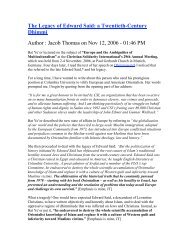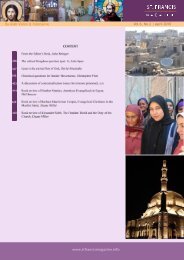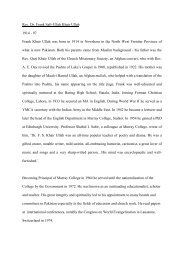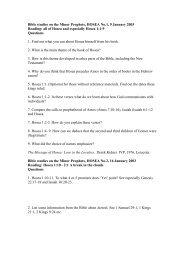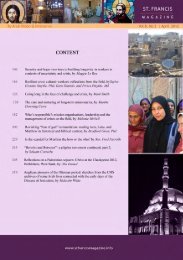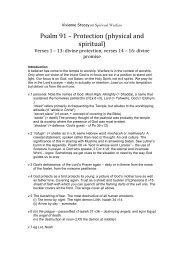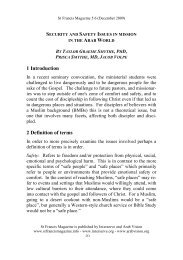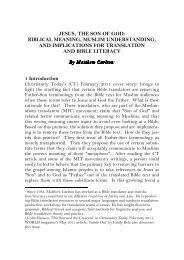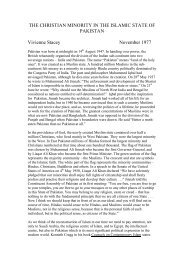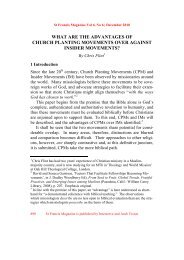download the pdf - St.Francis Magazine
download the pdf - St.Francis Magazine
download the pdf - St.Francis Magazine
Create successful ePaper yourself
Turn your PDF publications into a flip-book with our unique Google optimized e-Paper software.
<strong>St</strong> <strong>Francis</strong> <strong>Magazine</strong> Vol 8, No 4 | August 2012<br />
re-enact <strong>the</strong> death with knives, barbed chains, and swords, while<br />
onlookers participate vicariously by pounding <strong>the</strong>ir chests rhythmically.<br />
This <strong>the</strong>me of martyrdom replays itself from one year to <strong>the</strong><br />
next as professionals (rowzeh-khans) give recitals recounting <strong>the</strong><br />
sufferings of sacred figures in Shi’ism. The Shi’a passion play (tazieh)<br />
is preformed regularly across Iran, much like <strong>the</strong> Christmas<br />
pageants in <strong>the</strong> Christian West (Mackey 1998, 106). The life and<br />
death of Ali and <strong>the</strong> slaughter of Hussein on Ashura are part of <strong>the</strong><br />
metanarrative that has shaped <strong>the</strong> morality, values, and character of<br />
Iranians.<br />
In modern times, religion was relegated to a lesser position during<br />
<strong>the</strong> Pahlavi dynasty (1924-1979), in which Reza Shah implemented<br />
modernization along with secularization, which “required<br />
religion to be practiced at home” (Spellman 2004, 18). What ensued<br />
was an adjustment to a double life of public secularism and private<br />
religiosity. The religious scholars (ulama)have held an important<br />
position in Iranian society since <strong>the</strong> establishment of <strong>the</strong> Safavid<br />
dynasty (1501-1722). The modernization and secularization of <strong>the</strong><br />
Pahlavi government took much of <strong>the</strong> power and authority away<br />
from <strong>the</strong> ulama, thus severing <strong>the</strong> alliance between <strong>the</strong> ulama and<br />
<strong>the</strong> rich merchants and traders (bâzâri) in <strong>the</strong> market (bazaar)<br />
(Spellman 2004, 20). This dismantling of <strong>the</strong> religious power base<br />
led to two important Shia thinkers stepping onto <strong>the</strong> political stage<br />
in <strong>the</strong> 1960s and 1979. They were a layman, Ali Shariati, and a cleric,<br />
Ayatollah Ruhollah Khomeini. Shariati popularized <strong>the</strong> idea of<br />
returning to Islam as a way of life and establishing an Islamic government.<br />
Later, Khomeini developed <strong>the</strong> doctrine of rule of <strong>the</strong> jurisprudent<br />
(Velâyat-e Faqih), which advocates that in <strong>the</strong> absence of<br />
<strong>the</strong> ‘Hidden Imam’ (from ‘Twelver Shia’ belief) it is important to<br />
appoint a supreme ruler who has complete knowledge of Islamic law<br />
and total justice (Spellman 2004, 21). Religious symbols and ideas,<br />
whe<strong>the</strong>r martyrdom and sacrifice or referring back to <strong>the</strong> utopian<br />
Golden years of Islam, were used to draw strong communal boundaries<br />
and create social insulation. Velayat-e faqih was defended by<br />
Ayatollah Beheshti, “In <strong>the</strong> present system leadership and legislation<br />
cannot be left to <strong>the</strong> majority at any given moment. This<br />
<strong>St</strong> <strong>Francis</strong> <strong>Magazine</strong> is a publication of Interserve and Arab Vision 407




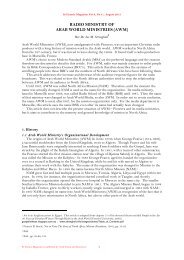
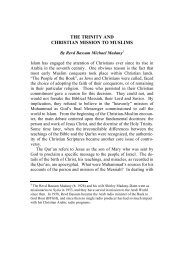
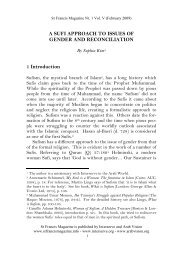
![Reflections on Surah Fatiha and the Lord's Prayer[1] - St.Francis ...](https://img.yumpu.com/49377951/1/184x260/reflections-on-surah-fatiha-and-the-lords-prayer1-stfrancis-.jpg?quality=85)
